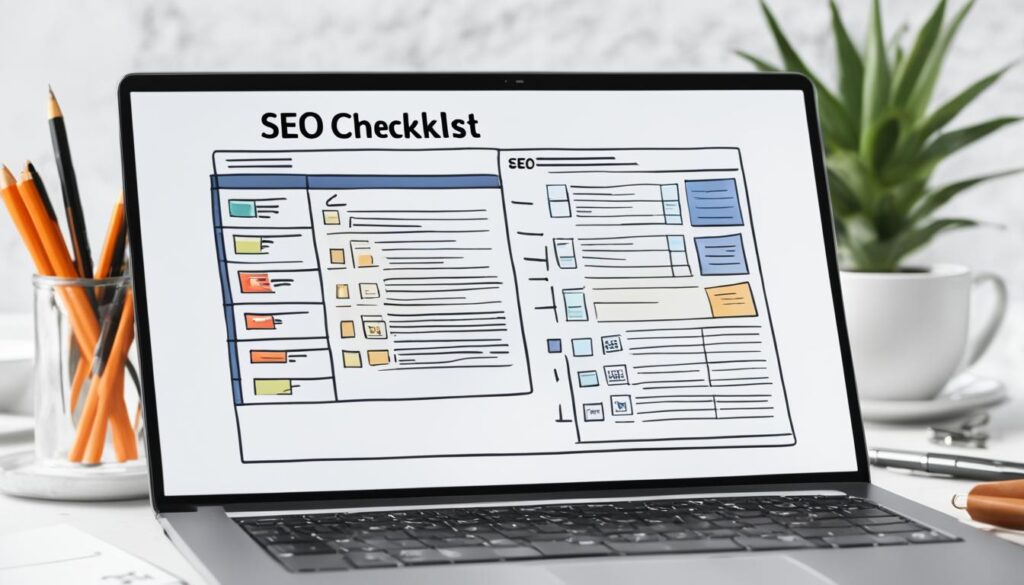Hey there, SEO enthusiasts! Today, I want to dive into the world of on-page optimization and guide you through the essential techniques and strategies to improve your website’s search visibility. Whether you’re a beginner or seasoned pro, this on-page SEO guide will equip you with the knowledge and tips you need to implement SEO best practices effectively.
On-page optimization involves optimizing various elements on your webpage to help search engines understand what your website is about. By fine-tuning your content, HTML elements, and website architecture, you can significantly boost your chances of ranking higher in the search results and driving organic traffic to your site. Exciting stuff, right?
But why is on-page SEO so critical? Well, think of it like this – when you optimize your website’s on-page factors, you make it easier for search engines to crawl, index, and rank your site. With better search visibility, you’ll attract more clicks and traffic, leading to increased engagement and conversions.
Now, let’s take a closer look at some of the essential on-page SEO factors you should focus on:
Key Takeaways:
- On-page SEO involves optimizing content, HTML elements, and website architecture.
- Understanding how search engines work is crucial for effective optimization.
- On-page SEO improves search visibility, click-through rates, and organic rankings.
- Essential on-page factors include content quality, HTML optimization, and website structure.
- A comprehensive on-page SEO checklist can help you cover all the important elements.
Understanding Search Engine Basics
When it comes to optimizing your website for search engines, it’s important to understand the basics of how they work. Search engines, like Google, employ crawlers to explore the internet and build a search index of websites. These crawlers analyze the content of each webpage they come across and evaluate its relevance to user queries.
Once the crawlers have gathered the necessary information, the search engine’s algorithm kicks in. This algorithm takes into account various factors to determine how well a particular webpage answers a user’s search query. The algorithm then assigns a ranking to each webpage, placing the most relevant and useful ones at the top of the search engine results pages (SERPs).
As website owners and marketers, our goal is to optimize our webpages in a way that aligns with the search engine’s algorithm. By understanding how search engines work, we can tailor our SEO strategies to meet the criteria that search engines look for when ranking webpages.
For example, we can focus on creating high-quality content that addresses user intent and incorporates relevant keywords. We can also optimize HTML elements, such as title tags and meta descriptions, to provide clear and concise information about our webpages. Additionally, we can ensure our website’s architecture is well-structured, with proper internal linking and mobile responsiveness.
By grasping the fundamentals of search engine operations, we can implement effective on-page SEO techniques that improve our website’s visibility in search results and attract more organic traffic.
To further illustrate the importance of understanding search engine basics, consider this analogy: imagine you’re preparing a presentation for an audience. To capture their attention and deliver your message effectively, you need to understand their interests, concerns, and thought processes. Similarly, search engines serve as the audience for our websites. By understanding how they think and what they’re looking for, we can optimize our content and website structure to resonate with them.
Now that we have a solid foundation of search engine basics, it’s time to dive deeper into the specific on-page SEO factors that can boost our website’s visibility and search rankings.
Key Concepts of Search Engine Basics
| Concept | Definition |
|---|---|
| Search engines | Software systems that help users find relevant information by searching the internet. |
| Crawlers | Automated bots that explore the internet, discover webpages, and gather information about their content. |
| Search index | A large database where search engines store information about webpages, allowing them to quickly retrieve relevant results. |
| Algorithm | A set of rules and calculations used by search engines to determine the relevance and ranking of webpages. |
| Search engine results pages (SERPs) | The pages displayed by search engines after a user submits a search query, containing a list of relevant webpages. |
Now that we have a better understanding of the basics, let’s explore the importance of on-page SEO in the next section.
Importance of On-Page SEO

On-page SEO plays a crucial role in improving your website’s search visibility and driving more organic traffic. When your website ranks higher in the search results, it not only increases the chances of being clicked but also boosts your click-through rates (CTR). A higher CTR indicates that your website’s content is relevant and compelling, attracting more visitors.
Optimizing your on-page SEO factors is essential to improve your organic ranking. By addressing key elements such as keyword optimization, content quality, and user experience, you can increase your website’s visibility and attract more targeted traffic from search engines.
On-page SEO is about creating an optimal user experience while ensuring that search engines can understand and index your website effectively. It involves optimizing various aspects of your website, including content, HTML elements, and website architecture, to provide valuable information to both users and search engines.
By focusing on on-page SEO, you have the opportunity to enhance your website’s visibility, drive more traffic, and improve your overall organic ranking. It’s a crucial aspect of your SEO strategy that should not be overlooked.
Implementing on-page SEO techniques and best practices will help you create a strong foundation for your website’s search visibility. It sets the stage for higher organic rankings, increased traffic, and improved click-through rates.
Next, we will explore the essential on-page SEO factors in detail, providing you with practical strategies to optimize your website effectively.
Essential On-Page SEO Factors

When it comes to on-page SEO, there are three main categories of factors that play a crucial role in optimizing your website for search engines. These categories include content, HTML, and website architecture, each with its own set of essential elements.
Content:
- E-A-T (expertise, authoritativeness, and trustworthiness): Building a trustworthy and authoritative website is crucial for on-page SEO. Creating high-quality, informative, and well-researched content that demonstrates expertise in your field will help improve your website’s visibility and credibility.
- Keyword optimization: Properly optimizing your content with relevant keywords is essential for improving search rankings. Conducting thorough keyword research and strategically incorporating these keywords throughout your content will help search engines understand the focus of your website.
- SEO writing techniques: Writing compelling, engaging, and user-friendly content that is optimized for search engines is a critical on-page SEO factor. Incorporating proper headings, subheadings, and formatting techniques such as using bold and italics can enhance the readability and SEO value of your content.
- Use of visual assets: Adding visual assets such as images, videos, infographics, and charts to your content can significantly improve user engagement and help convey information more effectively. Optimizing these visual assets by using descriptive filenames and alt attributes will enhance their search visibility.
HTML:
- Title tags: Optimizing your title tags with relevant keywords and a compelling description can greatly impact your website’s visibility in search engine results pages (SERPs).
- Meta descriptions: Writing concise and persuasive meta descriptions that accurately summarize the content of each webpage can improve click-through rates (CTR) and attract more organic traffic.
- Image optimization: Adding alt-text to your images using relevant keywords helps search engines understand the content and context of the images, increasing their chances of being ranked in image search results.
- Structured markup: Implementing schema markup and structured data on your website allows search engines to better understand the content and organization of your webpages, potentially leading to rich snippets and enhanced search visibility.
Website architecture:
- Page URLs: Creating clean, descriptive, and keyword-rich URLs for your webpages can improve their relevance and visibility in search results.
- Internal linking: Establishing a strong internal linking structure helps search engines navigate and index your website more effectively. Internal links also distribute authority and help users navigate between related content.
- Mobile responsiveness: Optimizing your website for mobile devices is crucial, as search engines prioritize mobile-friendly websites in their rankings. Ensure your website is responsive and provides a seamless user experience across different devices.
- Site speed: Optimizing your website’s loading speed has a significant impact on user experience and SEO. A faster website not only improves user satisfaction but also helps search engines crawl and index your site more efficiently.
Considering these essential on-page SEO factors will help you optimize your website effectively, improve its search rankings, and drive more organic traffic.
On-Page SEO Checklist

To optimize your website’s on-page SEO, here is a checklist of important factors to consider:
- Keyword Research: Conduct thorough keyword research to target relevant keywords for your content.
- Visual Content: Utilize visually engaging content such as images and videos to enhance user engagement.
- Page Titles: Optimize your page titles to clearly reflect the content and include relevant keywords.
- Headers: Use descriptive headers (H1, H2, H3, etc.) to organize your content and improve readability.
- Meta Descriptions: Write compelling meta descriptions that accurately summarize your page’s content and include relevant keywords.
- Image Alt-Text: Add descriptive alt-text to your images to improve accessibility and keyword relevancy for search engines.
- Structured Markup: Implement structured data markup to provide search engines with additional context about your content.
- Page URLs: Optimize your page URLs to be concise, descriptive, and include relevant keywords.
- Internal Linking: Create a solid internal linking structure to improve site navigation and enhance the user experience.
- Mobile Responsiveness: Ensure your website is mobile responsive, providing a seamless experience across devices.
- Site Speed: Optimize your website’s loading speed to enhance user satisfaction and improve search engine rankings.
By following these on-page SEO best practices, you can increase your website’s search visibility, drive more traffic, and ultimately improve your online presence.
Conclusion
The on-page SEO techniques and optimization strategies discussed in this article are essential for improving your website’s visibility and driving more traffic. By implementing these factors and following the checklist, you can effectively optimize your website and enhance its search rankings. However, it’s important to remember that on-page SEO is an ongoing process that requires regular analysis and updates to stay ahead in the search results.
To achieve better results, I recommend regularly evaluating your optimization strategies and making necessary adjustments. By doing so, you can ensure your website remains optimized and continues to attract organic traffic. Remember, the key to successful on-page SEO lies in understanding and implementing the fundamental factors that contribute to website visibility and traffic.
Overall, on-page SEO is a critical component of your digital marketing strategy. By focusing on optimization, you can improve your website’s search rankings, increase visibility to your target audience, and drive more organic traffic. So, don’t overlook the power of on-page SEO and start implementing these techniques today to see a significant improvement in your website’s visibility and traffic.










